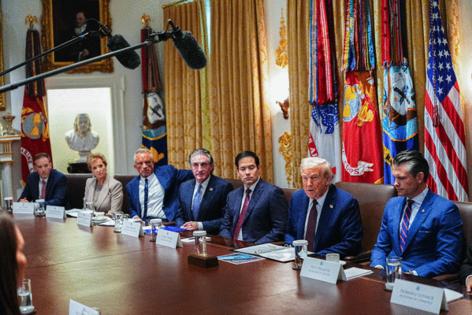Analysis: The US system always had loopholes. Trump 2.0 exploits what others resisted
Published in Political News
WASHINGTON — Call it the Trump Doctrine, Version 2.0.
The president and his second-term team have shown an unprecedented willingness to both ignore and exploit long-held traditions and norms that caused other chiefs executive to reject certain courses of actions.
Mix in the most expansive view of executive power in U.S. history, and the product has some Democrats and legal experts hearing the ghost of England’s King George III, the sovereign in London during the Revolutionary War, around every corner.
Trump on Tuesday contended he does not view himself as governing like a dictator. But 18 words he uttered during a televised three-hour Cabinet meeting revealed why his second-term governing approach has caused so many Democrats to make the dictator claim he rejects.
“I have the right to do anything I want to do. I’m the president of the United States,” he declared, uttering words his predecessors never dared to say publicly.
“If I think our country is in danger, and it is in danger in these cities, I can do it,” Trump said, referring to his threats to deploy National Guard troops and federal agents in Democratic-run cities he claims are too crime-riddled and poorly governed.
He has claimed during his seven months back in power, as he did during the Cabinet meeting, that he would “abide by the court” in rulings that go against his administration.
In reality, the Trump 2.0 administration has a mixed record at doing so.
Multiple times each week, it blows past what essentially were centuries-old gentlemen’s agreements that mostly stood the many tests of the last 249 years. Previous Oval Office occupants abided, resisted and recalibrated to ensure the executive did not being to take on king-like powers.
“This second administration is far more organized and planned-out than the first Trump team. This is all very calculated, from a political and a legal standpoint,” said one legal expert granted anonymity to speak freely during ongoing litigation against the White House.
Such loophole-exploiting moves include: ending so-called “birthright citizenship,” his mass deportation program, winding down congressionally created agencies like USAID and the Wilson Center, deploying troops to Los Angeles, threatening unfriendly law firms and universities into massive financial settlements, and others.
‘In a coma’
Trump and his team, essentially, have found a crucial loophole in the canon of laws and statutes that apply to the Executive Office of the President: few guardrails have been etched into law — after all, the office holds the veto pen.
“A lot, in fact a stunning amount, of what they have been doing is not illegal. It’s right at the margins — on purpose. Other presidents would not have gone there,” the legal expert said. “And there is zero — zero — political loss for them, when they do lose on one of these policies in court. They can tell MAGA that they tried. And, as we have seen, they can abide by most of the judge’s order — but maybe not all of it, and get away with it.”
Benjamin Wittes, editor in chief of Lawfare, wrote about a recent exchange while moderating a conference panel during which Jack Goldsmith, the Learned Hand Professor at Harvard Law School, observed about the Trump 2.0 Justice Department: “It is simply not acceptable to offer an opinion contrary to the one that the president, who is not a lawyer, wants to push.” Wittes pivoted off Goldsmith’s assessment with one of his own, writing that federal judges are coming to the realization they typically are “the first independent lawyer to review the government’s action or policy who is actually allowed to raise legal questions.”
Joyce Vance, a University of Alabama law professor, wrote in an Aug. 19 Substack post that “one of DOJ’s most important touchstones … is exercising judgment and acting with restraint,” adding: “That Justice Department appears to be dead, or at least in a coma.”
Veteran political commentator and analyst Chris Cillizza put it this way Tuesday: “I assumed that there were a series of laws and regulations that would limit Trump’s ability to follow some of his worst instincts in office.
“But, what has become very clear to me in the first 7 months of the Trump presidency is that there are far fewer legal constraints on a president than I assumed,” added Cillizza, a Roll Call alum. “Even the top legal scholars in the country are forced to admit that they aren’t totally sure whether Trump can do what he is trying to do because, well, no president has ever tried it before.”
Democratic National Committee Chairman Ken Martin this week told his party mates that it was time to “stand up and fight.” The opposition party has struggled to do so, without control of the House or Senate, and with the Supreme Court divided in Trump’s favor, 6-3.
While some Democrats, like California Gov. Gavin Newsom, have taken a tougher rhetorical stance against Trump in recent months, the party overall has continued to struggle with a breakthrough message and still lacks a figure that could bring its often-bickering factions together.
Martin, at his party’s summer meeting in Minneapolis, tried some Newsom-like talk, referring to Trump as the “dictator-in-chief” and his second administration as “fascism dressed in a red tie.”
“We are the only thing standing in his way,” Martin said, seeming to ignore that, mostly, has been a job for federal courts.
‘Rather have the dictator’
And though polls show Trump’s approval and favorability ratings hovering around 40%, those numbers have not plummeted since his barrage of loophole-exploiting moves.
For instance, 41% of respondents to a YouGov-Economist survey released Tuesday said they view Trump favorably, while 56% view him unfavorably. (By comparison, 31% view Newsom favorably, while 43% do not.)
Trump and his loyalists have not exactly tried to hide the Trump 2.0 doctrine. In fact, they have parked it in plain sight.
“The line is that I’m a dictator. But I stop crime,” he said Tuesday, referring to his federal policing takeover in Washington. “So a lot of people say, ‘You know, if that’s the case, I’d rather have a dictator.'”
Trump is again threatening to ignore a norm that, with a handful of exceptions, has held for centuries.
“I see black women (in Chicago) wearing a red MAGA hat last night on television. ‘Please let the president come in. My son was attacked.’ … You have a force of black women — black women, they’re like, ‘Only Trump.’ They want Trump to come in,” he told reporters, during what Roll Call’s Factba.se clocked as the longest-ever Trump televised event, at just over 3 hours and 16 minutes. “Look, it’s not about winning elections because we want to have nice, fair elections. It’s not politics. We want to see a safe country.”
One Republican source with ties to Trump world said Friday that the president’s threats to Democratic-run cities could be an attempt to get them to step up policing and security measures. Still, the source would not rule out federal troops and agents soon patrolling the Windy City — adding there is more to come.
“And it won’t just be continuing what we’ve seen. He’s hellbent on keeping the House next year because he wants to take many of these executive orders and turn them into legislation so future presidents can’t just come in on the first day and say, ‘I don’t want to do that. Cancel this,’” the source added.
And on whatever executive orders White House staff secretary Will Scharf might hand Trump in the Oval Office this week or next month or during a loaded fall-winter legislative session, the GOP source predicted more of the same.
“The Democrats go bonkers over this stuff and sue just because Trump is the one proposing it,” the source said, adding of the White House: “But they know what they’re doing.”
_____
©2025 CQ-Roll Call, Inc., All Rights Reserved. Visit cqrollcall.com. Distributed by Tribune Content Agency, LLC.
























































Comments